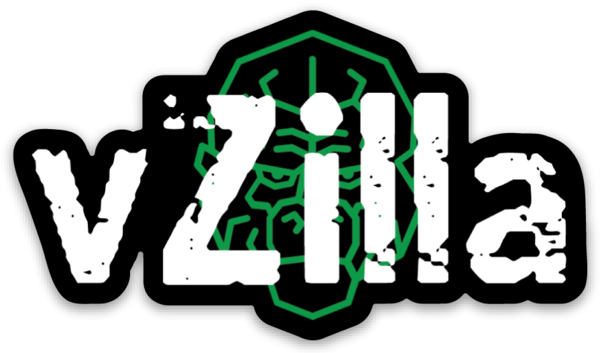In the last post we covered the fundamentals at a very high level on why you should be considering adding a backup action into your GitOps workflows, we also deployed ArgoCD into our Kubernetes cluster. In this post we are going to walkthrough a scenario on why and how having that backupaction within in your process ensures that when mistakes happen (and they will) your data is protected and can be recovered easily.
This walkthrough assumes that you have Kasten K10 deployed within your Kubernetes Cluster to perform these steps. More details on this can be found at https://docs.kasten.io/latest/index.html
This is a very simple example of how we can integrate Kasten K10 with ArgoCD. It’s voluntary kept very simple because we focus on using Kasten K10 with a pre-sync phase in ArgoCD.
You can follow along this walkthrough using the following GitHub Repository.
Phase 1 – Deploying the Application
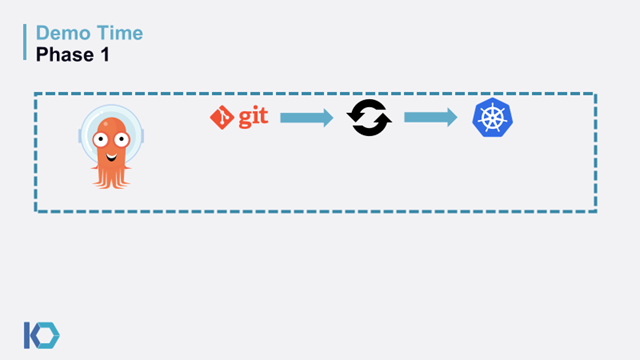
First let us confirm that we do not have a namespace called mysql as this will be created within ArgoCD
We create a mysql app for sterilisation of animals in a pet clinic.
This app is deployed with Argo CD and is made of: * A mysql deployment * A PVC * A secret * A service to mysql
We also use a pre-sync job (with corresponding sa and rolebinding) to backup the whole application with kasten before application sync.
At the first sync an empty restore point should be created.
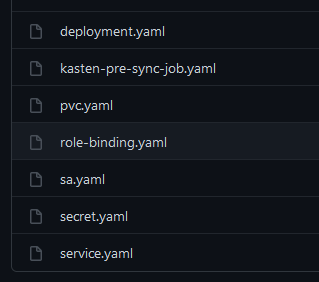
To look at the Kasten Pre Sync file you can see below the hook and sync wave that we have used here, this indicates that this will be performed before any other task. More details can be found in the link above.

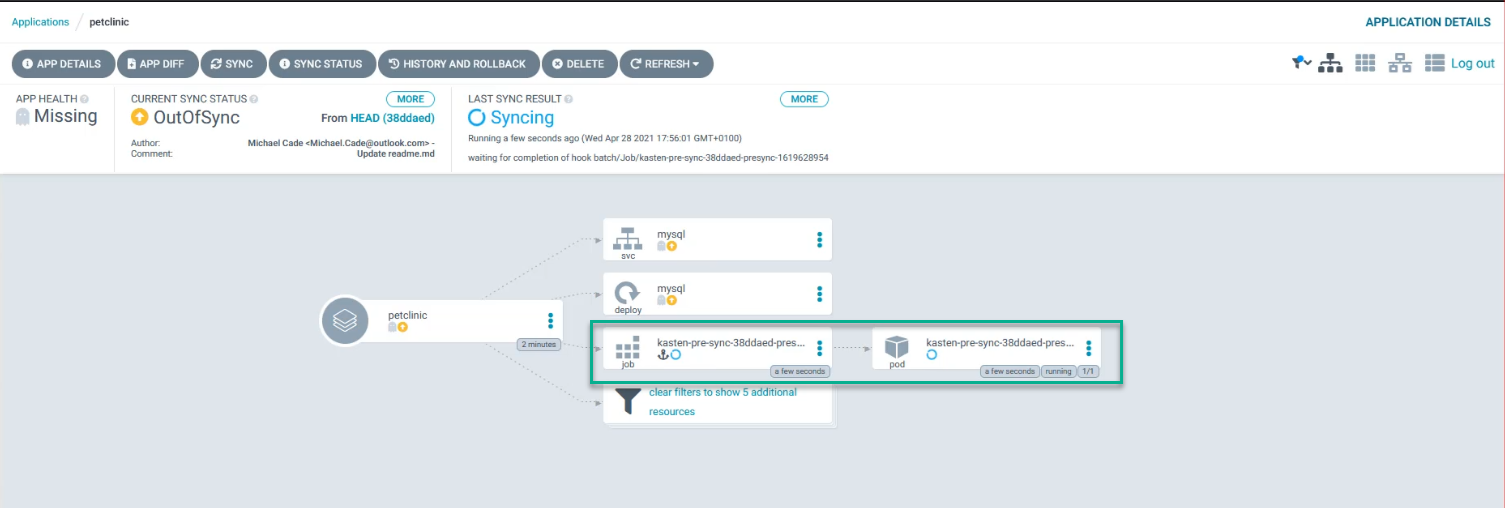
Phase 2 – Adding Data
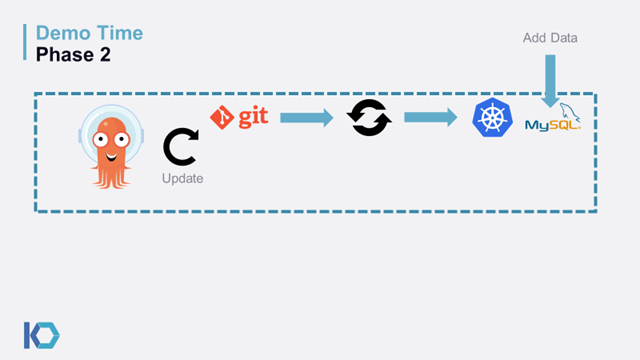
The scenario we are using here is of a vet clinic where there is a requirement to log all information of their patients for safe keeping and understanding what has happened to each one.
Vets are creating the row of the animal they will operate.
mysql_pod=$(kubectl get po -n mysql -l app=mysql -o jsonpath='{.items[*].metadata.name}’)
kubectl exec -ti $mysql_pod -n mysql — bash
mysql –user=root –password=ultrasecurepassword
CREATE DATABASE test;
USE test;
CREATE TABLE pets (name VARCHAR(20), owner VARCHAR(20), species VARCHAR(20), sex CHAR(1), birth DATE, death DATE);
INSERT INTO pets VALUES (‘Puffball’,’Diane’,’hamster’,’f’,’2021-05-30′,NULL);
INSERT INTO pets VALUES (‘Sophie’,’Meg’,’giraffe’,’f’,’2021-05-30′,NULL);
INSERT INTO pets VALUES (‘Sam’,’Diane’,’snake’,’m’,’2021-05-30′,NULL);
INSERT INTO pets VALUES (‘Medor’,’Meg’,’dog’,’m’,’2021-05-30′,NULL);
INSERT INTO pets VALUES (‘Felix’,’Diane’,’cat’,’m’,’2021-05-30′,NULL);
INSERT INTO pets VALUES (‘Joe’,’Diane’,’crocodile’,’f’,’2021-05-30′,NULL);
SELECT * FROM pets;
exit
exit
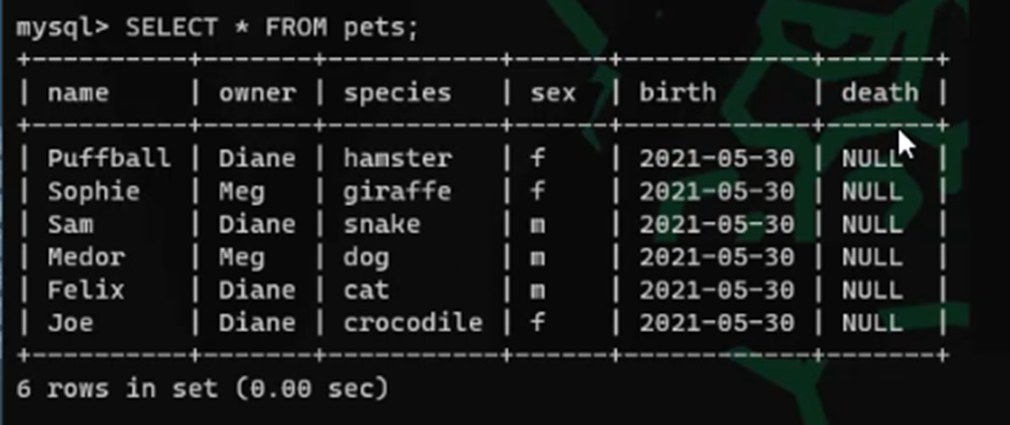
Phase 3 – ConfigMaps + Data
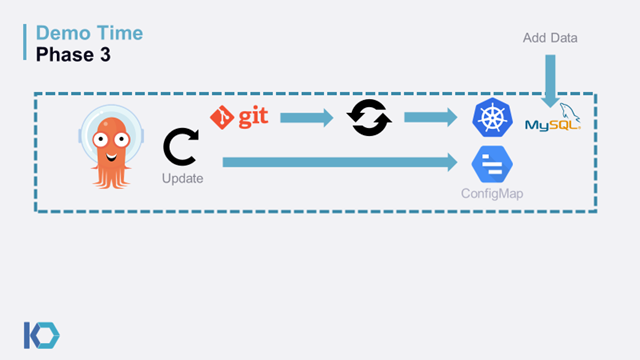
We create a config map that contains the list of species that won’t be eligible for sterilisation. This was decided based on the experience of this clinic, operation on this species are too expansive. We can see here a link between the configuration and the data. It’s very important that configuration and data are captured together.
cat <<EOF > forbidden-species-cm.yaml
apiVersion: v1
data:
species: “(‘crocodile’,’hamster’)”
kind: ConfigMap
metadata:
name: forbidden-species
EOF
git add forbidden-species-cm.yaml
git commit -m “Adding forbidden species”
git push
When deploying the app with Argo Cd we can see that a second restore point has been created
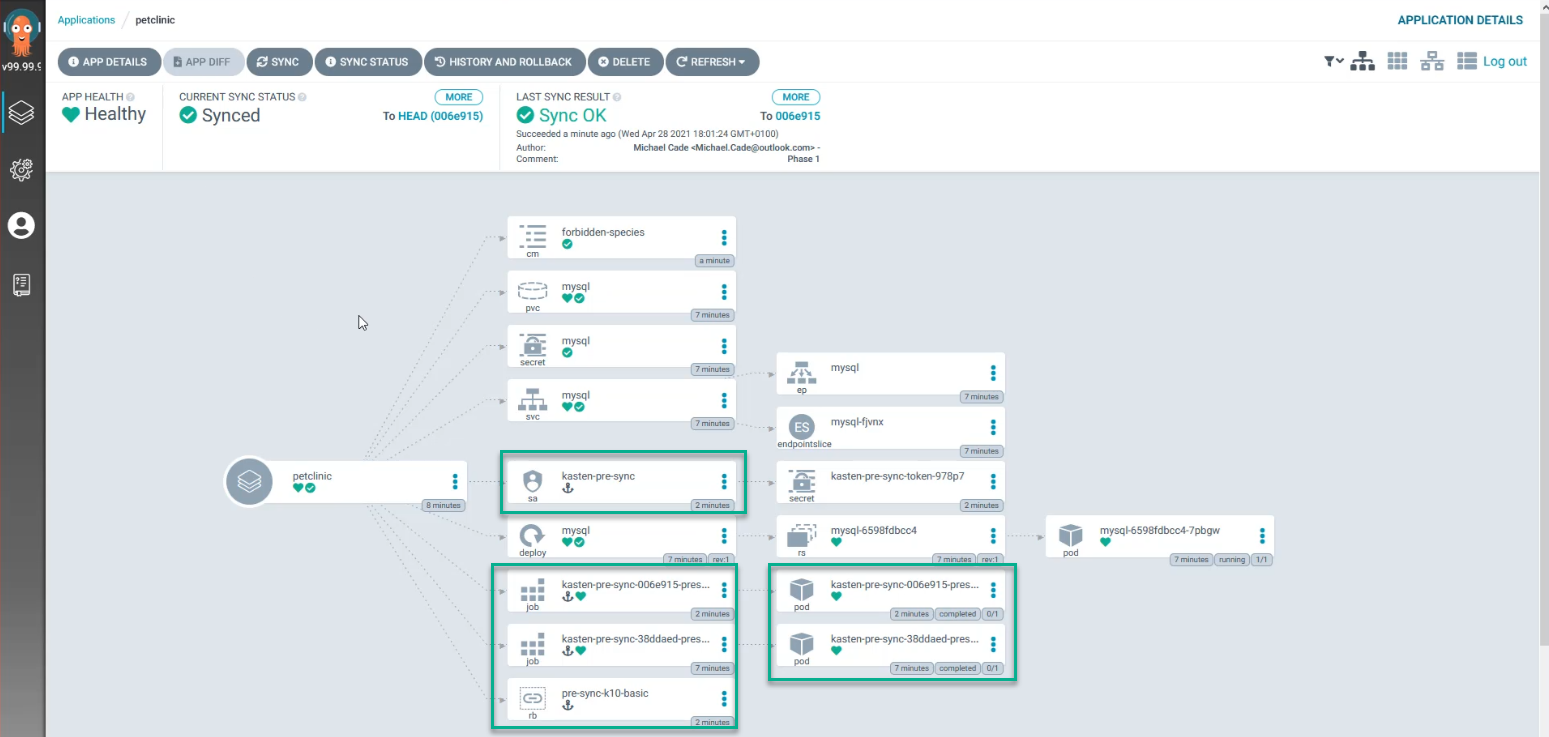
Phase 4 – The failure scenario
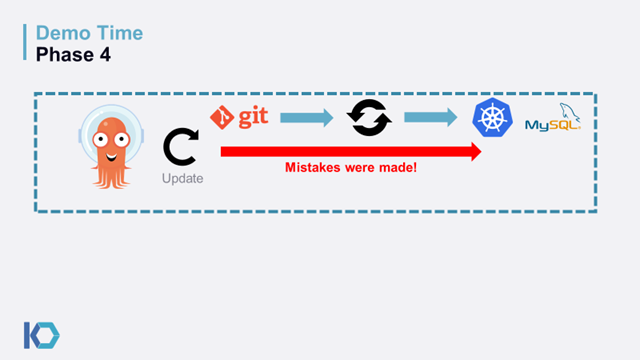
At this stage of our application we want to remove all the rows that have species in the list, for that we use a job that connects to the database and that deletes the rows.
But we made a mistake in the code and we accidentally delete other rows.
Notice that we use the wave 2 argocd.argoproj.io/sync-wave: “2” to make sure this job is executed after the kasten job.
cat <<EOF > migration-data-job.yaml
apiVersion: batch/v1
kind: Job
metadata:
name: migration-data-job
annotations:
argocd.argoproj.io/hook: PreSync
argocd.argoproj.io/sync-wave: “2”
spec:
template:
metadata:
creationTimestamp: null
spec:
containers:
– command:
– /bin/bash
– -c
– |
#!/bin/bash
# Oh no !! I forgot to the “where species in ${SPECIES}” clause in the delete command 🙁
mysql -h mysql -p\${MYSQL_ROOT_PASSWORD} -uroot -Bse “delete from test.pets”
env:
– name: MYSQL_ROOT_PASSWORD
valueFrom:
secretKeyRef:
key: mysql-root-password
name: mysql
– name: SPECIES
valueFrom:
configMapKeyRef:
name: forbidden-species
key: species
image: docker.io/bitnami/mysql:8.0.23-debian-10-r0
name: data-job
restartPolicy: Never
EOF
git add migration-data-job.yaml
git commit -m “migrate the data to remove the forbidden species from the database, oh no I made a mistake, that will remove all the species !!”
git push
now head on back to ArgoCD and sync again and see what damage it has done to our database.
Let’s now take a look at the database state after making the mistake
mysql_pod=$(kubectl get po -n mysql -l app=mysql -o jsonpath='{.items[*].metadata.name}’)
kubectl exec -ti $mysql_pod -n mysql — bash
mysql –user=root –password=ultrasecurepassword
USE test;
SELECT * FROM pets;

This shows below the 3 restore points that we had created via ArgoCD pre code changes.

Phase 5 – The Recovery
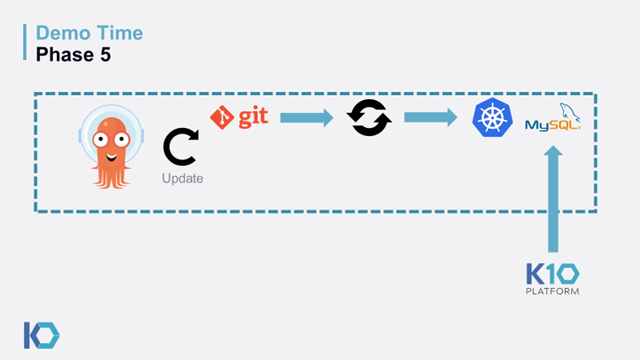
At this stage we could roll back our ArgoCD to our previous version, prior to Phase 4 but you will notice that this just brings back our configuration and it is not going to bring back our data!
Fortunately, we can use kasten to restore the data using the restore point.
You will see from the above now when we check the database our data is gone! It was lucky that we have this presync enabled to take those backups prior to any code changes. We can now use that restore point to bring back our data.
I am going to link here to how you would configure Kasten K10 to protect your workload but also how you would recover, this post is already getting too long.
Let’s now look at the database state after recovery
mysql_pod=$(kubectl get po -n mysql -l app=mysql -o jsonpath='{.items[*].metadata.name}’)
kubectl exec -ti $mysql_pod -n mysql — bash
mysql –user=root –password=ultrasecurepassword
USE test;
SELECT * FROM pets;
If you have followed along then you should now see good data.
Phase 6 – Making things right
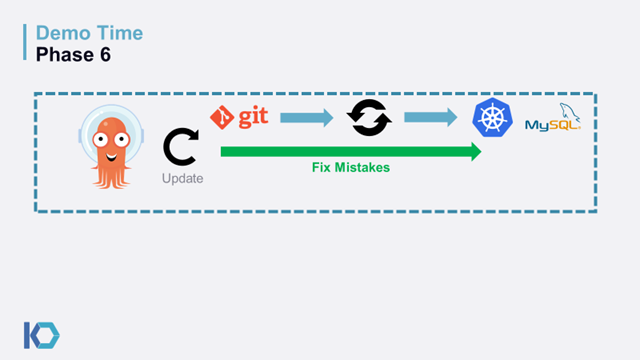
We have rectified our mistake in the code and would like to correctly implement this now into our application.
cat <<EOF > migration-data-job.yaml
apiVersion: batch/v1
kind: Job
metadata:
name: migration-data-job
annotations:
argocd.argoproj.io/hook: PreSync
argocd.argoproj.io/sync-wave: “2”
spec:
template:
metadata:
creationTimestamp: null
spec:
containers:
– command:
– /bin/bash
– -c
– |
#!/bin/bash
# Oh no !! I forgot to the “where species in ${SPECIES}” clause in the delete command 🙁
mysql -h mysql -p\${MYSQL_ROOT_PASSWORD} -uroot -Bse “delete from test.pets where species in ${SPECIES}”
env:
– name: MYSQL_ROOT_PASSWORD
valueFrom:
secretKeyRef:
key: mysql-root-password
name: mysql
– name: SPECIES
valueFrom:
configMapKeyRef:
name: forbidden-species
key: species
image: docker.io/bitnami/mysql:8.0.23-debian-10-r0
name: data-job
restartPolicy: Never
EOF
git add migration-data-job.yaml
git commit -m “migrate the data to remove the forbidden species from the database, oh no I made a mistake, that will remove all the species !!”
git push
Another backup / restore point is created at this stage.
Let’s take a look at the database state and make sure we now have the desired outcome.
mysql_pod=$(kubectl get po -n mysql -l app=mysql -o jsonpath='{.items[*].metadata.name}’)
kubectl exec -ti $mysql_pod -n mysql — bash
mysql –user=root –password=ultrasecurepassword
USE test;
SELECT * FROM pets;
At this stage you will have your desired data in your database but peace of mind that you have a way of recovering if this accident happens again.
You can now check your database and you will see the configmaps now manipulates your data as you originally planned.
Clean Up
If you are using this as a demo, then you may now want to clean up your environment to run this multiple times. You can do this by following the next steps.
Delete App from ArgoCD in the UI – There will also be a way to remove from ArgoCLI but I have not had chance to find this yet.
Delete namespace
kubectl delete namespace mysql
Delete rolebinding
kubectl delete rolebinding pre-sync-k10-basic
